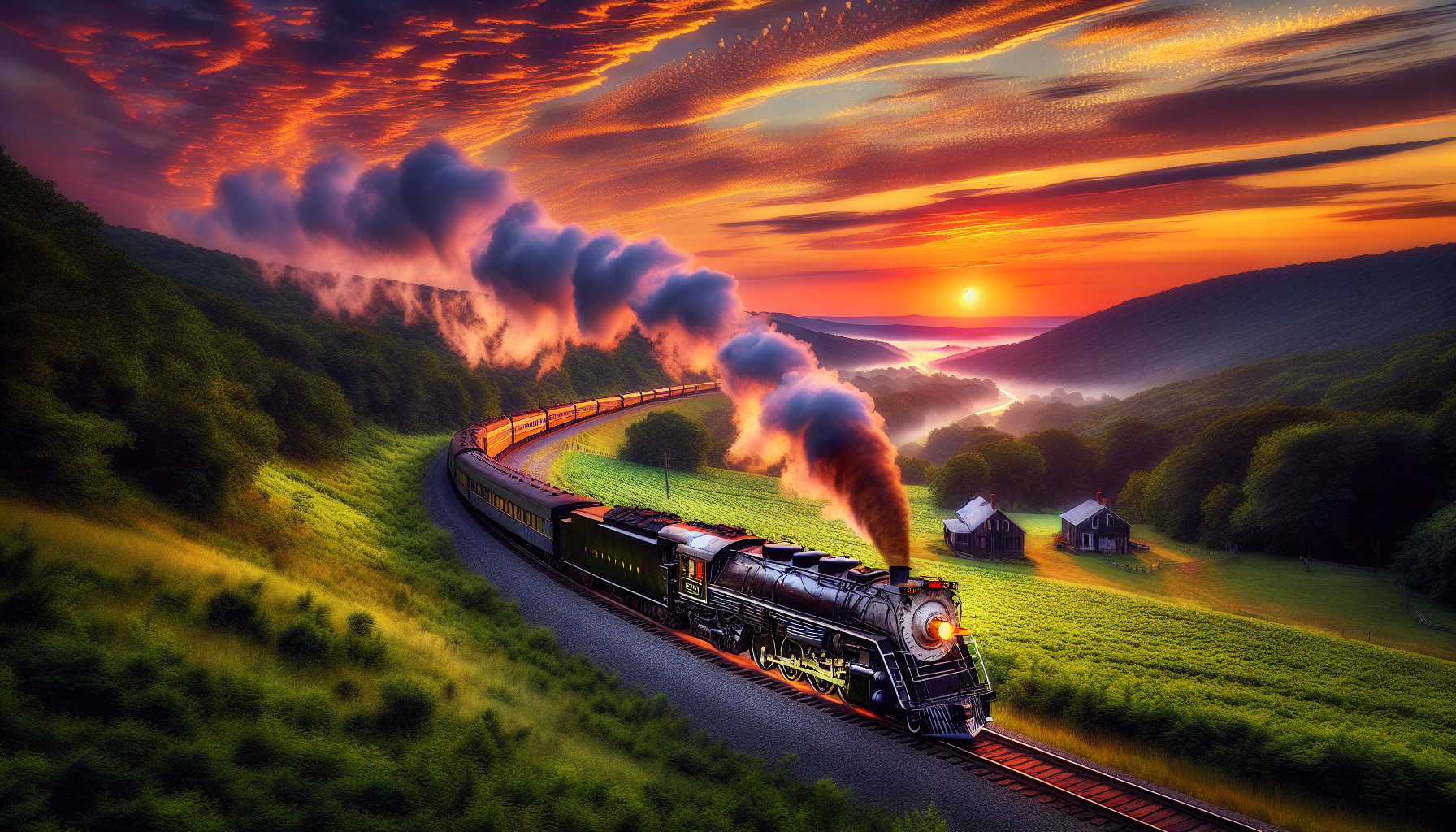Salisbury Viaduct: From Trains To Recreational Use
Published: July 12, 2024
By: Adam Burns
Salisbury Viaduct is an iconic structure in Somerset County, Pennsylvania, known not only for its engineering prowess but also for its transformation from a functional railway bridge into a cherished part of the Great Allegheny Passage trail.
Spanning over a mile in length, this viaduct has weathered the test of time and stands as a testament to both early 20th-century railway ingenuity and contemporary efforts in rail-to-trail conversion.
This article delves into the rich history of the Salisbury Viaduct, detailing its construction, specifications, operational history, and eventual repurposing for recreational use.
 The most impressive feature of the Connellsville Extension was Salisbury Viaduct, which crossed the Baltimore & Ohio's Chicago main line on Sand Patch grade near Meyersdale, Pennsylvania. The bridge is seen here in 1965.
The most impressive feature of the Connellsville Extension was Salisbury Viaduct, which crossed the Baltimore & Ohio's Chicago main line on Sand Patch grade near Meyersdale, Pennsylvania. The bridge is seen here in 1965.Initial Conception and Construction
Commissioned during the early 20th century, the Salisbury Viaduct was part of the Western Maryland Railway's ambitious Connellsville Extension. The Connellsville Extension, completed in 1912, connected Cumberland, Maryland, to Connellsville, Pennsylvania.
This extension required the construction of several significant structures to navigate the challenging Appalachian terrain, and the Salisbury Viaduct was one of its most remarkable engineering feats.
The principal reason behind the construction of the viaduct was to provide a more direct and efficient route for transporting coal and other freight from the resource-rich Appalachian region to major industrial centers in the Northeastern and Midwestern United States.
The Westernn Maryland recognized the economic potential of such a route and invested in the construction of the viaduct to overcome the geographical challenges presented by the Casselman River Valley.
Constructed using steel girders and concrete piers, the Salisbury Viaduct stretches an impressive 1,908 feet (approximately 0.36 miles) in length and stands about 101 feet above the Casselman River and the adjacent valley floor. The viaduct's length and height made it one of the largest and most imposing structures on the Connellsville Extension.
It was designed to accommodate heavy freight trains, necessitating a solid and durable construction to support substantial loads while ensuring safety and efficiency.
Operational History
The Salisbury Viaduct officially opened in 1912, coinciding with the completion of the Connellsville Extension. For several decades, it played a crucial role in the operations of the Western Maryland Railway, facilitating the movement of coal, raw materials, and finished goods.
In general the line was the company's primary east-west routing and also acted as part of the much larger "Alphabet Route" handling expedited freight between the Northeast and Midwest.
The viaduct witnessed the growth and transformation of the American industrial landscape, contributing to the economic development of the region it traversed.
However, the mid-20th century brought significant changes to the American railway industry. The rise of alternative transportation modes, such as trucking and automobiles, coupled with the decline of the coal industry, led to a decrease in railway traffic.
By the 1970s, the once-bustling Salisbury Viaduct saw a significant reduction in usage, and the Western Maryland Railway eventually ceased operations on the Connellsville Extension.
Closure and Decline
The decline of the Salisbury Viaduct as a functional railway bridge culminated in its official closure to rail traffic in the spring of 1975.
By then the WM was part of the Baltimore & Ohio's system and the new owner elected to use its own main line over Sand Patch. Ironically, WM's corridor was the better engineered route with lower grades although it was not double-tracked.
The subsequent years saw the structure fall into disuse and disrepair, reflecting the broader challenges faced by the American railway industry during this period of transformation and decline.
The abandonment of the viaduct marked the end of an era, but it also set the stage for a new chapter in its history. As the structure stood idle, various stakeholders began to recognize its potential for repurposing.
This recognition would eventually lead to its inclusion in the growing rail-to-trail movement—a nationwide initiative aimed at converting disused railway corridors into recreational trails for public use.
Conversion into the Great Allegheny Passage Trail
The vision to transform the Salisbury Viaduct into a recreational trail began to take shape in the 1980s and 1990s.
The Great Allegheny Passage (GAP) trail, a project that sought to create a continuous route for hikers, cyclists, and outdoor enthusiasts, emerged as a driving force behind the repurposing efforts.
Recognizing the potential of the viaduct as a critical link in this trail, stakeholders from various sectors—including local communities, government agencies, and trail advocacy organizations—collaborated to bring the vision to life.
The conversion process involved significant rehabilitation and retrofitting of the viaduct to ensure its safety and accessibility for trail users. Stabilizing the structure, improving the surface, and adding safety features such as railings and interpretive signage were key components of the project.
The restoration efforts were guided by a commitment to preserving the historical and architectural integrity of the viaduct while adapting it for contemporary recreational use.
In 1998, the Salisbury Viaduct was officially opened to the public as part of the Great Allegheny Passage trail. The transformation was greeted with enthusiasm and marked a milestone in the broader rail-to-trail movement.
The viaduct, once a conduit for industrial freight, was now a scenic pathway for outdoor enthusiasts, connecting them to the natural beauty and historical significance of the region.
Specifications and Features
The Salisbury Viaduct's conversion into a trail preserved many of its historical and engineering features while adding elements to enhance the recreational experience.
Spanning 1,908 feet, the viaduct offers panoramic views of the surrounding landscape, including the Casselman River Valley and rolling Appalachian hills.
The elevation of the viaduct—101 feet above the valley floor—provides a unique vantage point for trail users, offering both a sense of scale and an appreciation for the engineering prowess that went into its construction.
The surface of the trail on the viaduct is composed of crushed limestone, providing a smooth and durable path for hikers and cyclists. Railings along both sides ensure the safety of users, while interpretive signage offers insights into the viaduct's history, construction, and significance.
The trail's integration of historical interpretation with recreational use serves as a model for other rail-to-trail projects, highlighting the potential to honor the past while creating new opportunities for public engagement and enjoyment.
Continued Legacy and Usage
Since its conversion, the viaduct has become a beloved and frequently visited segment of the Great Allegheny Passage. Outdoor enthusiasts from near and far are drawn to the trail for its scenic beauty, historical significance, and recreational opportunities.
The viaduct's inclusion in the GAP trail has also contributed to the economic vitality of the surrounding communities, attracting tourism and fostering a sense of local pride.
Moreover, the Salisbury Viaduct stands as a testament to the power of collaborative efforts in preserving and repurposing historical infrastructure.
The successful transformation of the viaduct into a trail underscores the potential of adaptive reuse projects to create meaningful connections between history, nature, and contemporary usage.
Conclusion
Salisbury Viaduct's journey from a functional railway bridge to a celebrated recreational trail encapsulates a narrative of change, resilience, and renewal.
Its construction in the early 20th century as part of the Western Maryland's Connellsville Extension marked a significant engineering achievement.
While the viaduct's operational years as a railway bridge eventually came to an end, its rebirth as part of the Great Allegheny Passage trail has ensured its continued relevance and appreciation.
Today, the viaduct stands not just as a relic of the past, but as a vibrant pathway that connects people to both history and nature.
It serves as an enduring symbol of how historical infrastructure can be thoughtfully repurposed to serve contemporary purposes, enriching the lives of those who traverse its length and preserving its legacy for future generations.
Recent Articles
-
Virginia Wine Tasting Train Rides
Jul 07, 25 10:45 PM
Wine tasting trains in Virginia provide just that—a unique experience that marries the romance of rail travel with the sensory delights of wine exploration. -
Vermont Wine Tasting Train Rides
Jul 07, 25 10:39 PM
Known for its stunning green mountains, charming small towns, and burgeoning wine industry, Vermont offers a unique experience that seamlessly blends all these elements: wine tasting train rides. -
Indiana's Whiskey Train Rides
Jul 07, 25 10:31 PM
Whether you're a local resident or a traveler looking to explore Indiana from a unique perspective, hopping on a whiskey train ride is a journey worth considering.


